
Royal artist, architect and designer to Georgian kings
William Kent (1685-1748) rose from humble origins as sign painter. Commissioned by George I and George II, he became one of the most successful and fashionable designers of the Georgian period. His work can still be seen at Kensington Palace and Hampton Court Palace.
Kent was the first British designer to tackle the interior as a whole; extending an architect’s control to every detail of interior decoration, fireplaces and furnishings.

Image: William Kent (third from left) depicted in his own painting on the King's Staircase at Kensington Palace. Pictured alongside him are his mistress, Elizabeth Butler, and two of his assistants. © Historic Royal Palaces
William Kent, Georgian designer
Yorkshire-born William Kent began his working life as a sign and coach painter. His employer recognised his greater talent, and Kent was sent to study art in Italy, thanks to several wealthy patrons.
A charming and skilful social climber, he made several influential friends on his travels, including the wealthy and sophisticated Earl of Burlington.
A skilful social climber
In 1719, Kent returned to London from his Italian travels, looking for work. His friend Lord Burlington used his high-ranking contacts to introduce the young artist to the royal household.
George I was searching for a ‘dazzling’ painter to decorate his new state apartments at Kensington; Kent saw his chance. He undercut the official royal painter, Sir James Thornhill’s quote by several hundred pounds, and won the job.
Did you know?
Kent’s first royal commission stirred up jealousy: a highly-critical rival suggested that he had cheated on his materials to save money!
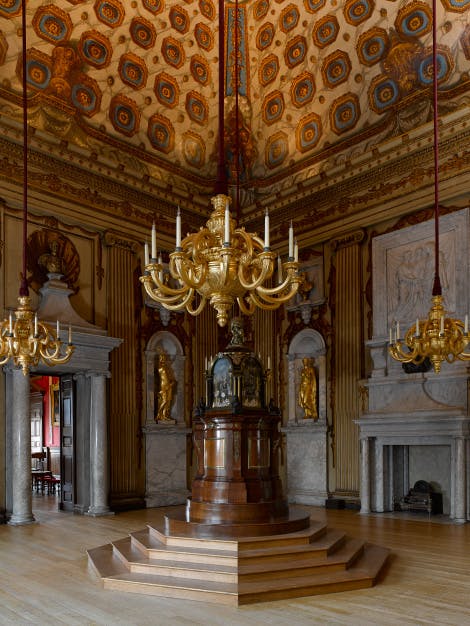
Image: At the centre of the Cupola Room is an 18th-century musical clock, known as the 'Temple of the Four Great Monarchies of the World'. © Historic Royal Palaces
The room that launched a career
With his rivals brushed aside, and with George I’s blessing, Kent set to work on the largest of the state apartments, the Cupola Room.
He was closely monitored by a nit-picking committee from the Office of Works, but his new fashionable Italianate style (and Kent’s powerful friends) tipped the balance of opinion in his favour. And George I loved the clever décor, full of eye-tricking illusions.
Kent made the whole room resemble a four-sided Roman cupola (a rounded dome). The illusion is enhanced by the steeply curved ceiling, with the Garter Star at its apex.
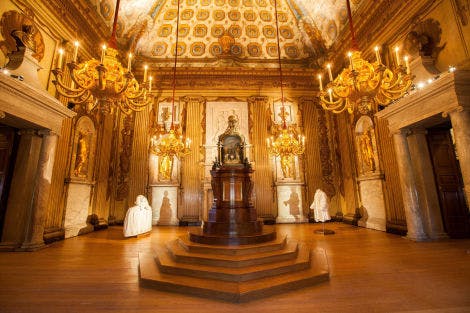
Image: A general view of the Cupola Room.
The Cupola Room
When the room was finished, with its painted pilasters, marble chimney piece and gilded lead statues it must have dazzled in the flickering candlelight, but others called it a ‘terrible glaring show’. However, George I loved it.
Kent went on to decorate several other rooms at the palace, including the extraordinary King’s Staircase.
He also remodelled and redecorated the King’s Gallery, originally built for William III, between 1725 and 1727.
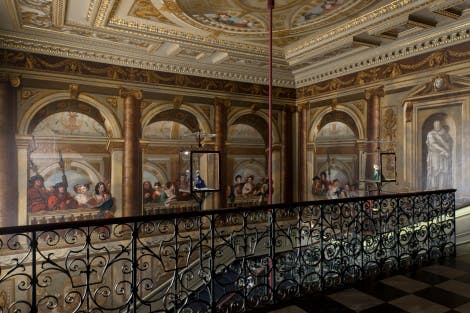
Image: The King's Staircase © Historic Royal Palaces
A painter, architect and father of modern gardening. In the first... he was below mediocrity; in the second he was a restorer of the science, in the last an original...
Horace Walpole, who thought Kent’s real talent was for landscape design
William Kent at Hampton Court Palace
An apartment for a spoilt second son
By 1732, William Kent’s work at Kensington Palace had won him a huge number of admirers, among them George II and Queen Caroline.
The King commissioned Kent to improve the royal accommodation at Hampton Court Palace, in particular to transform the dilapidated Tudor royal apartments in Clock Court into a sumptuous apartment for their favoured second son, William Augustus, Duke of Cumberland.
Did you know?
The doted-on William Augustus grew up to be a vicious military commander, nicknamed 'The Butcher of Culloden'.
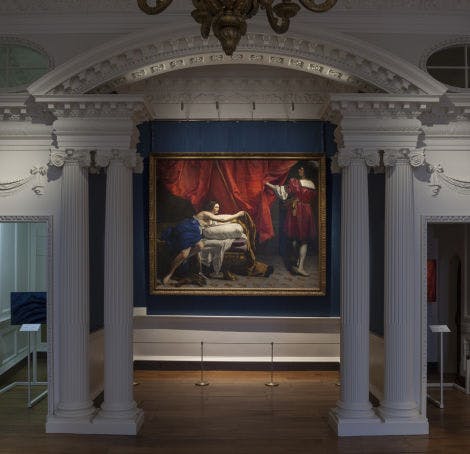
Image: The former Cumberland Suite newly re-presented as a flexible royal art gallery with a rotating display of masterpieces from the Royal Collection. © Historic Royal Palaces
Fit for a prince
Little expense was spared for the favoured son’s new suite of rooms at Hampton Court.
Kent designed the new range in Gothic style, with other architectural elements, in an attempt to match the Tudor buildings around it.
This image shows one of the four final rooms of the Duke’s grand apartments, which today have become the Cumberland Art Gallery, housing a fabulous rotating collection of Royal Collection artworks.

Image: The Queen's Staircase. © Historic Royal Palaces
The Queen's Staircase
In 1734, Queen Caroline invited her favourite architect and designer, William Kent to redecorate the stairs to the Queen’s State apartments at Hampton Court Palace. Kent’s Roman-inspired setting includes an homage to the Queen, whom he compares to the ancient goddess Britannia.
On the west wall of the Queen's Staircase, now part of the Georgian Story, is the painting Mercury Presenting the Liberal Arts to Apollo and Diana by Gerrit van Honthorst, 1628.
The wrought-iron balustrade was designed by the Huguenot ironworker Jean Tijou, who also created the Tijou Screen in the Privy Garden.
Kent painted the walls with a series of trompe l’oeil (trick of the eye) niches and half-domed spaces with classical sculptures, and the Garter star and royal ciphers within the ceiling.

Image: The Cupola Room at Kensington Palace. © Historic Royal Palaces
William Kent's death and legacy
William Kent went on to be a highly successful and much-sought after designer. Apart from the palaces of Kensington and Hampton Court, his other houses, gardens and interiors can be seen all over England. However, his work divided opinion both during his life and after his death. To some he was a multi-talented genius; to others, ‘opportunistic’ and ‘over-rated’.
Everyone agrees that the man himself was fond of the good life, with his love of ‘high feeding and inaction’ clearly demonstrated in his ample proportions, and probably leading to his relatively early death in 1748.
Kent never married, and left his mistress Elizabeth Butler part of his £10,000 estate.
Browse more history and stories

Mehmet von Königstreu
An Ottoman gentleman at George I’s Court
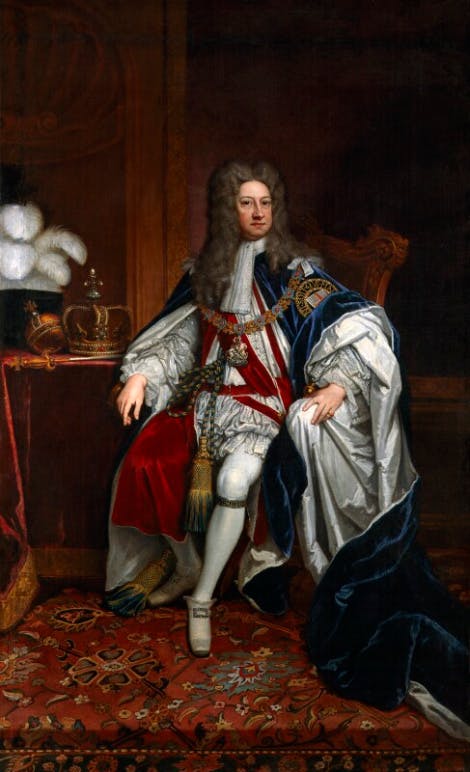
Kings and queens of the Georgian period
Who were the Georgians – the kings and their queens who gave their name to an era?

The story of Kensington Palace
An elegant retreat for Britain's royal family
Explore what's on

- Things to see
The King's State Apartments
Wander through the lavish rooms of the King's State Apartments, each one grander than the last, at Kensington Palace.
- Open
- In line with palace opening hours
- Kensington Palace
- Included in palace admission (Members go free)

- Things to see
The King's Staircase
Discover the intriguing and unexpected characters depicted on the grand entrance to the King's State Apartments.
- Open
- In line with palace opening hours
- Kensington Palace
- Included in palace admission (Members go free)

- Things to see
The King’s Gallery
Explore the King's Gallery, which was transformed by William Kent to showcase the finest paintings of the Royal Collection.
- Open
- In line with palace opening hours
- Kensington Palace
- Included in palace admission (Members go free)
Shop online

Courtiers: The Secret History of Kensington Palace
Told through the eyes of a courtier, this fascinating book explores the ambitious and talented people who flocked to the Georgian court in search of power and prestige.
£12.99

